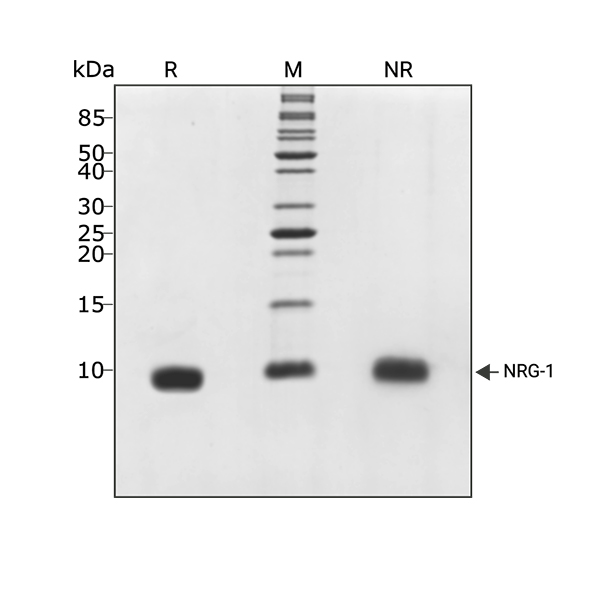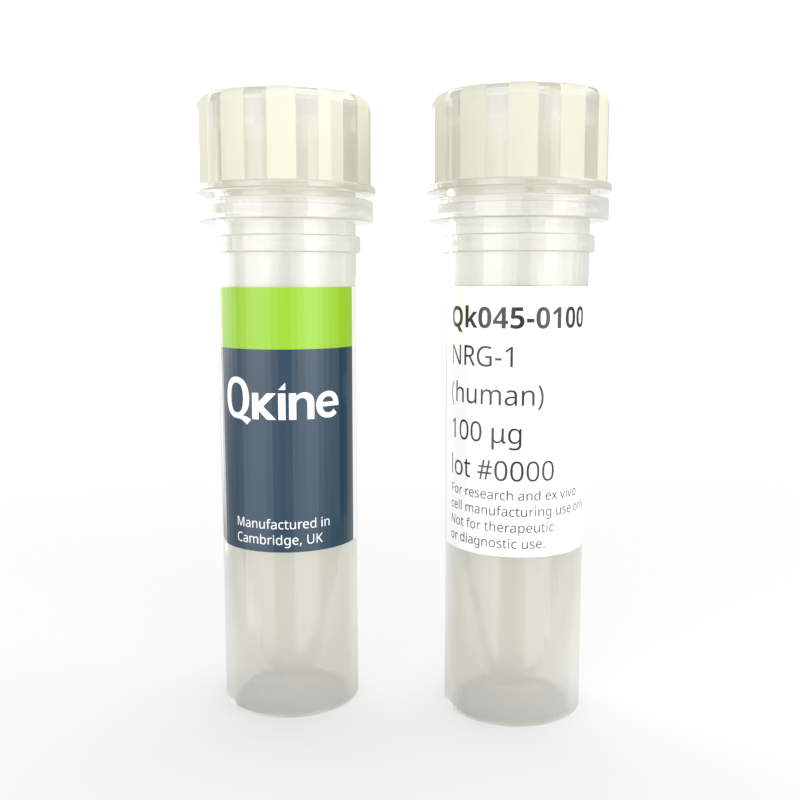Currency
Recombinant human NRG-1 protein (Qk045)
Human NRG-1 protein (neuregulin 1) is frequently used in the maintenance of human pluripotent stem cells. In addition to its widespread use in stem cell culture media, NRG-1 (also known as Heregulin-β1 , HRG-1) has essential roles in vivo including in nervous system, cardiac, and mammary gland development; cancer biology and neurological disorders.
7.5 kDa highly pure, bioactive domain of human NRG-1, comprised of the β isoform of the EGF-like domain of NRG-1 (HRG1-B1). This NRG-1 protein monomer is animal origin-free (AOF) and carrier-protein free (CF).
Orders are typically shipped same or next day (except Friday).
Easy world-wide ordering, direct or through our distributors.
1000µg will be despatched as 2 x 500µg
Fast and free shipping.
Buy online with secure credit card or purchase order.
For any questions, please email orders@qkine.com
Summary
High purity human NRG-1 protein (Uniprot: Q02297)
>98%, by SDS-PAGE quantitative densitometry
7.5 kDa
Expressed in E. coli.
Animal origin-free (AOF) and carrier protein-free.
Manufactured in our Cambridge, UK laboratories
Lyophilized from acetonitrile, TFA
Resuspend in water at >100 µg/ml, prepare single use aliquots, add carrier protein if desired and store frozen at -20°C or -80°C
Featured applications
human
species similarity:
mouse – 98%
rat – 83%
porcine – 100%
bovine – 100%
Related discovery kits
Bioactivity

NRG-1 activity is determined using the Promega serum response element luciferase reporter assay (*) in transfected MCF-7 cells. Cells are treated in triplicate with a serial dilution of NRG-1 for 4 hours. Firefly luciferase activity is measured and normalized to the control Renilla luciferase activity. EC50 = 37.9 pM (0.28 ng/mL). Data from Qk045 lot #104317. *Promega pGL4.33[luc2P/SRE/Hygro] #E1340
Purity

NRG-1 migrates as a single band at 7.5 kDa in non-reducing (NR) conditions and upon reduction (R). No contaminating protein bands are visible. Purified recombinant protein (3 µg) was resolved using 18% w/v SDS-PAGE in reduced (+β-mercaptothanol, R) and non-reduced (NR) conditions and stained with Coomassie Brilliant Blue R250. Data from Qk045 batch #104317.
Further quality assays
Mass spectrometry: single species with expected mass
Analytical reversed-phase: single sharp peak
Endotoxin: <0.005 EU/μg protein (below level of detection)
Recovery from stock vial >95%
We are a company founded and run by scientists to support innovation in stem cell biology and regenerative medicine. To enhance reliability and reproducibility in your applications, all our products are exceptionally high purity, with complete characterisation and bioactivity analysis on every lot.
Protein background
Neuregulin 1 (NRG-1) is a member of the neuregulin family (along with NRG 2-4). Each member of this family is encoded by an individual gene. Alternative splicing and different promoter utilisation results in a large number of isoforms for each member of the protein family – for example, NRG-1, the best studied member, generates six types of protein (I–VI) and at least 31 isoforms [1]. These isoforms have different tissue distribution, potency, receptor specificity and biological functions [2].
All NRG-1 isoforms contain the bioactive EGF-like domain, this EGF-like domain has two isoforms: alpha and beta. These differ in their receptor affinity; both the alpha and beta isoforms are ligands for the receptors ErbB3 (HER3) and ErbB4 (HER4), however the NRG-1 beta isoform has a higher affinity for the ErbB4 receptor than the alpha isoform [3]. This protein (Qk045) consists of the β isoform of the EGF domain of NRG-1 protein.
NRG-1 has an essential role in cardiac and neuronal development, and is implicated in disorders such as schizophrenia [4], and numerous cancers, for example breast cancer where NRG-1 promotes the proliferation and migration of breast cancer cells [5]. In cell culture, NRG-1 is frequently used in maintenance media for human pluripotent stem cells and other cells.
Publications using recombinant human NRG-1 protein (Qk045)
Refined home-brew media for cost-effective, weekend-free hiPSC culture and genetic engineering.
In Open Research Europe 2024 by Truszkowski, L., Bottini, S., Bianchi, S. et al.
Our products are for research use only and not for diagnostic or therapeutic use. Products are not for resale.



What others are saying
There are no contributions yet.